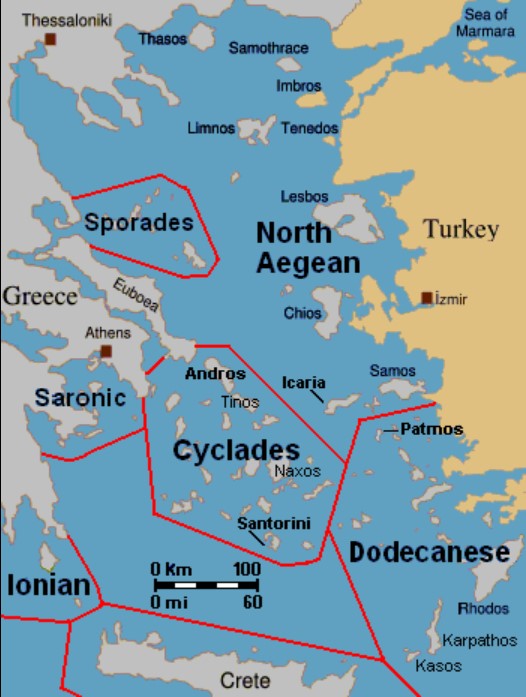The country of Greece is famous for its islands – there are around 6,000 islands and islets scattered in the Greek Seas, of which only 227 islands are inhabited.

They are split into 8 main groups that include (from North to South):
Sporades,
North Aegean,
Evia (Euboea),
Saronic,
Cyclades,
Ionian,
Dodecanese and
Crete.
The Argosaronic islands are the ones closest to the Greek mainland around the Saronic Gulf. They tend to be the location of the wealthy holiday homes from the mainland. Argosaronic islands include: Aegina, Agistri, Hydra, Poros, Salamina, and Spetses,
The Cyclades are the most famous island group in the Aegean Sea. All up there are 33 Islands and Islets in the group and they include: Amorgos, Anafi, Andros, Antiparos, Delos, Ios, Kea, Kimolos, Kythnos, Milos, Mykonos, Naxos, Paros, Folegandros, Serifos, Sifnos, Sikinos, Syros, Tinos, and Thira or Santoríni. The Cyclades are famous for their distinctive architecture, the whitewashed cube-shaped houses.
Crete is the largest island in Greece, and the fifth largest in the Mediterranean Sea.
The Dodecanese is a group of 15 larger plus 150 smaller islands in the south-eastern Aegean and the eastern Mediterranean. The group includes Agathonisi, Astypalaia, Halki, Kalymnos, Karpathos, Kasos, Kos, Leipsoi, Leros, Nisyros, Patmos, Rhodes, Symi, Tilos, and Kastellorizo.
Evia (Euboea), is one of the closest to Athens and yet it is one of the most unknown. It is the second largest island of Greece and the 6th in the Mediterranean. It is linked to the mainland by two bridges.
The Ionian Islands are off the western coastline of Central Greece in the Ionian Sea. They consist of 7 main islands and some smaller Islets. The Ionian Islands are: Cefalonia, Corfu, Cythera, Lefkos, Ithaca, Paxos, and Zante. These islands share a lot of similarities like the Venetian architecture, lush greenery and turquoise waters.
North Aegean Islands do not form a physical chain or group, but are frequently grouped together for tourist or administrative purposes. Most of them belong to Greece with a few owned by Turkey. The islands include: Agios Efstratios, Chios, Fournoi Korseon, Ikaria, Lemnos, Lesbos, Oinousses, Psara and Samos and the Turkish islands of Imbros, Tenedos and the Rabbit or Tavşan Islands.
The Sporades (meaning scattered) islands run along the east coast of Greece, northeast of Evia (Euboea). They consist of 24 islands, four of which are permanently inhabited: Alonnisos, Skiathos, Skopelos and Skyros.
So what else is important to know…
Language – Greece offers English language lessons starting in third grade, so almost everyone under the age of 50 will have had English in school and will know enough to communicate well. But as usual, try to learn a few Greek words, your effort will be appreciated
What is the best way to get around? – Some of the islands do have airports but when island hopping the ferries are an excellent way to get around but they are subject to regular changes and updates. So definitely do not set and forget.
When is the best time to travel to the Greek Islands? – High season for the Greek Islands are July and August but the warmer months are between mid-April to mid-October. Shoulder season will usually allow for cheaper prices and manageable crowds.
Can I drink the water? – Yes on the mainland but stick to bottled water on the majority of the islands.
Toilets – A sticking point for many, but for most of Greece the sewage system is very old. This means that toilet paper cannot be flushed and must be put into a bin by the side of the toilet.
Siesta – Be aware that stores usually close between mid-day and around 2-3 pm as Greek shop owners have their siesta. Don’t worry the shops will be open until 9 or 10pm so you won’t miss out.
Sundays – many services, restaurants, shops, grocery stores and even some markets are all generally closed on Sundays. The ones that are open may charge extra.
Don’t hesitate to ask for help. Greek people are generally extremely friendly, will understand that you are a tourist and will be willing to lend a hand.